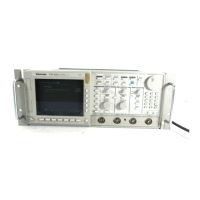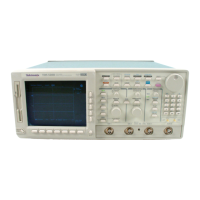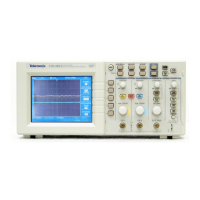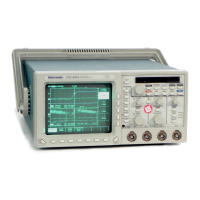Command Descriptions
TDS Family Oscilloscope Programmer Manual
2–187
FALL is the time that it takes for the falling edge of a pulse to fall from a HighRef
value to a LowRef value of its final value.
FREQuency is the reciprocal of the period measured in hertz.
HIGH is the 100% reference level.
LOW is the 0% reference level.
MAXimum is the highest amplitude (voltage).
MEAN is the arithmetic mean over the entire waveform.
MINImum is the lowest amplitude (voltage).
NDUty is the ratio of the negative pulse width to the signal period expressed as a
percentage.
NOVershoot is the negative overshoot, expressed as:
NOVershoot + 100
ǒ
(Low * Minimum)
Amplitude
Ǔ
NWIdth is the distance (time) between MidRef (usually 50%) amplitude points of
a negative pulse.
PDUty is the ratio of the positive pulse width to the signal period expressed as a
percentage.
PERIod is the time, in seconds, it takes for one complete signal cycle to happen.
PHAse is the phase difference from the selected waveform to the designated
waveform.
PK2pk is the absolute difference between the maximum and minimum amplitude.
POVershoot is the positive overshoot, expressed as:
POVershoot + 100
ǒ
(Maximum * High)
Amplitude
Ǔ
PWIdth is the distance (time) between MidRef (usually 50%) amplitude points of
a positive pulse.
RISe is the time that it takes for the leading edge of a pulse to rise from a low
reference value to a high reference value of its final value.
RMS is the true Root Mean Square voltage.

